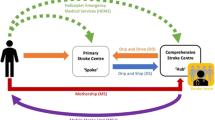Abstract
Background:
The treatment of patients with cerebral infarction due to vascular stenosis/occlusion includes a range of therapeutic options such as intravenous recombinant tissue plasminogen activator (rtPA) application, thrombocyte aggregation inhibition, anticoagulation, intraarterial thrombolytic medication as well as carotid endarterectomy and endovascular procedures (angioplasty or stenting of extra- and intracranial vessels). Both the drug therapies and endovascular techniques are expected to expand significantly over the next few years. The challenge consists in achieving optimal patient selection for specific therapeutic options.
Objective:
This position paper is a review and expert consensus document in neuromedicine, concerning the bridging concept in neurovascular diseases. It is the authors' approach to propose guidelines designed to ensure that patients with acute stroke who may be candidates for rapid revascularization have a chance to receive this type of treatment. In this ongoing multidisciplinary discussion all organizational, technical and personnel resources provided by stroke centers and cooperating hospitals should be harmonized and optimized. To ensure that no valuable time is lost and that the available time is used optimally, it may make sense to start systemic application of rtPA for thrombolysis following a diagnosis of nonhemorrhagic brain infarct and confirmation of suitability by means of teleneuromedical systems (TNS) until interventional therapy options or intraarterial local treatment can be initiated. This so-called bridging technique can further increase the success rate of treatment compared to exclusive intraarterial procedures.
Outlook and Recommendations:
Endovascular therapeutic options are still considered difficult, expensive, and risky, and should be reserved for specialized centers with experienced staff. Therefore, the selection process must be extensive, thorough and precise and patients must be allocated to centers without delay. Through the diffusion of certain techniques, in particular CT- or MRI-guided techniques (CTA, CTP, MRA, DWI, PWI), specific endovascular therapy protocols can be customized to select certain subtypes of stroke. Optimal pathways for specific infarct subtypes, where combined therapy strategies (bridging concepts) are perhaps most attractive, but fairly difficult to establish, should be developed in the near future.
Zusammenfassung
Hintergrund:
Die Therapie von Patienten mit akutem Hirninfarkt, verursacht durch Gefäßstenose bzw. Gefäßverschluss, umfasst aktuell vielfältige Möglichkeiten, u.a. intravenösen rekombinanten Gewebe-Plasminogenaktivator (rtPA), Thrombozytenaggregationshemmer, Antikoagulation, intraarterielle Thrombolyse, Karotisendarteriektomie und endovaskuläre Techniken (Angioplastie bzw. Stentapplikation). Sowohl medikamentöse Therapien als auch endovaskuläre Techniken werden in den nächsten Jahren deutlich zunehmen. Die Herausforderung besteht in einer optimalen Patientenselektion bezüglich einzelner spezifischer Therapieoptionen.
Ziel:
Dieses Positionspapier stellt ein Review und eine neuromedizinische Expertenmeinung bezüglich Bridging-Konzepten bei neurovaskulären Erkrankungen dar. Es ist das Anliegen der Autoren, Empfehlungen zu formulieren, die es den Patienten mit Hirninfarkten ermöglichen, rasche Rekanalisationsmethoden als Therapieoption zu erhalten. In dieser anhaltenden multidisziplinären Diskussion sollten alle organisatorischen, technischen und personellen Ressourcen zur Verfügung gestellt werden, um eine optimale Abstimmung zwischen den Stroke-Unit-Zentren und den Kooperationskliniken zu erreichen. Um sicherzustellen, dass keine wichtigen Minuten verloren gehen, sollte evtl. eine systemische Thrombolyse mit rtPA in einer peripheren Kooperationsklinik nach teleneuromedizinischer Vorstellung des Patienten und gemeinsamer Indikationsstellung begonnen werden, bis im Stroke-Unit-Zentrum eine interventionelle Therapie eingeleitet werden kann. Dieses sog. Bridging-Konzept kann im Vergleich mit alleinigem intraarteriellem Vorgehen möglicherweise die Erfolgsrate bezüglich Rekanalisation und Outcome deutlich erhöhen.
Ausblick und Empfehlungen:
Endovaskuläre Therapieoptionen sind nach wie vor schwierig, kostenintensiv und risikoreich, so dass diese Methoden spezialisierten Zentren mit Expertise vorbehalten bleiben. Demnach sollte ein Hauptaugenmerk auf der Patientenselektion liegen, um geeignete Kandidaten ohne Zeitverzug in diese Zentren zu bringen. Durch die flächenmäßig weite Verbreitung zerebrovaskulärer Diagnostik (CTA, CTP, MRA, DWI, PWI) können bestimmte endovaskuläre Therapieprotokolle angepasst und für bestimmte Hirninfarktsubtypen etabliert werden. Zukünftig bedarf es aber eines besonderen Einsatzes, um diese optimierten Handlungspfade für kombinierte Therapiestrategien zu etablieren, da sie zwar sehr attraktiv, aber in randomisierten Studien schwierig zu untersuchen sind.
Similar content being viewed by others
Author information
Authors and Affiliations
Corresponding author
Rights and permissions
About this article
Cite this article
Ickenstein, G.W., Isenmann, S., Fiehler, J. et al. Thrombolysis in Neuromedicine. Clin Neuroradiol 18, 88–97 (2008). https://doi.org/10.1007/s00062-008-8010-z
Received:
Accepted:
Issue Date:
DOI: https://doi.org/10.1007/s00062-008-8010-z




